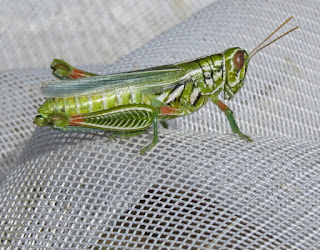I am terribly behind in chronicling field experiences I have participated in this summer, including the second annual(?) "grasshopper hunt" co-sponsored by Mile High Bug Club and the Aiken Audubon Society. Our first one was held last year at Homestead Ranch Regional Park near Peyton, Colorado. This time we opted to head farther south and a little farther east to Chico Basin Ranch; and we were led by grasshopper expert Bill Maynard.
The ranch is a sprawling 87,000 acres that straddles the El Paso and Pueblo County line. Its wide array of habitats, from sandhills to artificial wetlands, makes for high biodiversity, especially among insects and grasshoppers in particular. In only a few hours our party of roughly ten people observed forty (40) species of grasshoppers, plus many other insects and arachnids.
Bill is rather new to the study of grasshoppers, but he quickly masters many aspects of natural history. He is already recognized as a leading authority on birds and dragonflies, with many state and county records to his credit. It is only a matter of time before the same can be said of his expertise in the order Orthoptera to which grasshoppers belong.
Rather than overwhelming you with images here, I will direct you to the Mile High Bug Club Flickr Group where you can peruse the image collection at your leisure.
We would be remiss if we did not also acknowledge the hospitality of the Chico Basin Ranch staff, especially Tess Leach and her family. Her two children were especially curious, and remarkably patient and gentle in their approach to the many grasshoppers we saw.
The intense heat of that August 6 day sent some members of our party packing by about noon, but who could blame them? The Plains Harvestfly, a type of cicada, made it seem hotter still with its loud, oppressive buzz. All in all, the "expedition" was a resounding success, and no vehicles or people were injured during the odyssey.
While plains and deserts are prime habitats for grasshoppers, you can find them nearly everywhere. You will be surprised by the number of species you can discover in your own backyard, neighborhood park, vacant lot, or any other patch of wildness. Even now, with the first frosts approaching, grasshoppers are among the few insects left in any abundance. Go take a look for them.





I have seen grasshppers survive temps into the teens, into early November, I assume the take refuge in leaf litter and thatch?
ReplyDeleteExcellent point! I have seen the same thing. Will be keeping my eye out for them throughout the coming weeks. I know that nymphs of several species survive the winter, so the leaf litter cover hypothesis seems correct.
Delete